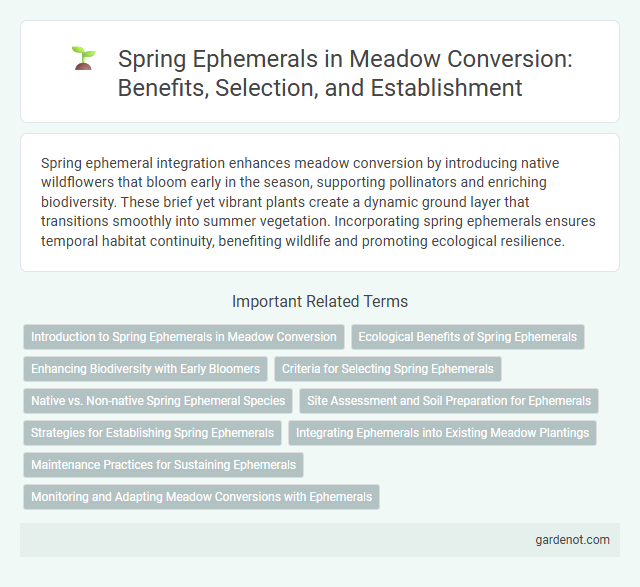Spring ephemeral integration enhances meadow conversion by introducing native wildflowers that bloom early in the season, supporting pollinators and enriching biodiversity. These brief yet vibrant plants create a dynamic ground layer that transitions smoothly into summer vegetation. Incorporating spring ephemerals ensures temporal habitat continuity, benefiting wildlife and promoting ecological resilience.
Introduction to Spring Ephemerals in Meadow Conversion
Spring ephemerals, a group of short-lived woodland plants, play a crucial role in meadow conversion by emerging early in the growing season before tree canopy closure. Their integration enhances biodiversity, improving soil health and providing critical habitats for pollinators and other wildlife. Emphasizing native spring ephemeral species during meadow conversion supports ecosystem resilience and promotes sustainable land management.
Ecological Benefits of Spring Ephemerals
Spring ephemerals provide crucial ecological benefits by emerging early in the season, supporting pollinators with vital nectar and pollen sources when few other plants are in bloom. Their rapid life cycle aids in soil stabilization and nutrient cycling, enhancing soil health and reducing erosion in meadow conversions. Integrating spring ephemerals fosters biodiversity by creating habitat for insects and small wildlife during critical early spring periods.
Enhancing Biodiversity with Early Bloomers
Spring ephemeral integration in meadow conversion enhances biodiversity by introducing early bloomers such as trout lilies, bloodroot, and spring beauties. These native wildflowers provide critical nectar and pollen sources for pollinators emerging from dormancy, sustaining early-season insects and birds. By fostering a diverse temporal flowering sequence, early bloomers improve habitat resilience and ecological balance in restored meadow ecosystems.
Criteria for Selecting Spring Ephemerals
Selecting spring ephemerals for meadow conversion requires evaluating their adaptability to local soil conditions, moisture levels, and light availability. Prioritizing species with rapid life cycles ensures early nutrient cycling and ground cover before canopy closure. Selecting native, pollinator-friendly plants with proven resilience supports ecosystem stability and biodiversity enhancement.
Native vs. Non-native Spring Ephemeral Species
Native spring ephemeral species, such as Bloodroot (Sanguinaria canadensis) and Trillium (Trillium spp.), are adapted to local soil and climate conditions, promoting biodiversity and ecosystem stability in meadow conversions. Non-native species may compete with native flora, potentially disrupting established plant-pollinator relationships and altering nutrient cycling within meadow ecosystems. Integrating native spring ephemerals supports sustainable meadow restoration by enhancing native pollinator habitats and maintaining ecological balance.
Site Assessment and Soil Preparation for Ephemerals
Site assessment for integrating spring ephemerals in meadow conversion requires detailed evaluation of soil pH, moisture levels, and existing vegetation to ensure optimal growing conditions. Soil preparation focuses on loosening compacted layers, incorporating organic matter, and minimizing disturbance to preserve the delicate root structures of ephemerals. Accurate mapping of microhabitats supports targeted planting and enhances survival rates of native ephemeral species.
Strategies for Establishing Spring Ephemerals
Establishing spring ephemerals requires selecting native species with early growth and flowering cycles optimal for local climates, ensuring successful establishment before canopy closure. Utilizing seed scattering or bulb planting techniques in well-prepared, undisturbed soil promotes healthy root system development and natural propagation. Incorporating periodic soil disturbance and controlling competing vegetation further enhances spring ephemeral integration into meadow conversions.
Integrating Ephemerals into Existing Meadow Plantings
Integrating spring ephemerals into existing meadow plantings enhances biodiversity and seasonal interest by introducing early-blooming native species like Bloodroot (Sanguinaria canadensis) and Trout Lily (Erythronium americanum). These ephemeral plants capitalize on sunlight availability before canopy closure, improving ground cover and supporting early pollinators such as mining bees and Andrena species. Effective integration requires careful selection of ephemerals suited to local soil and moisture conditions, ensuring harmonious growth alongside established grasses and wildflowers.
Maintenance Practices for Sustaining Ephemerals
Effective maintenance practices for sustaining spring ephemerals in meadow conversions include minimal soil disturbance to preserve bulb and rhizome structures and targeted seasonal mowing post-foliage senescence to prevent woody shrub encroachment. Regular monitoring for invasive species and careful application of selective herbicides support the long-term health of ephemeral populations. Incorporating periodic prescribed burns can enhance nutrient cycling and reduce competition, promoting optimal growth conditions for these early-spring native plants.
Monitoring and Adapting Meadow Conversions with Ephemerals
Monitoring spring ephemeral integration in meadow conversions involves tracking seasonal plant emergence and growth patterns to optimize habitat restoration efforts. Adapting meadow management practices based on real-time data from ephemeral species ensures enhanced biodiversity and resilience of native plant communities. Precise phenological monitoring supports timely interventions, promoting successful establishment and long-term sustainability of meadow ecosystems.
Spring ephemeral integration Infographic

 gardenot.com
gardenot.com